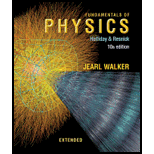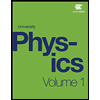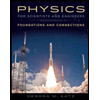
Fundamentals of Physics Extended
10th Edition
ISBN: 9781118230725
Author: David Halliday, Robert Resnick, Jearl Walker
Publisher: Wiley, John & Sons, Incorporated
expand_more
expand_more
format_list_bulleted
Concept explainers
Textbook Question
Chapter 16, Problem 35P
SSM Two sinusoidal waves of the same frequency travel in the same direction along a string. If ym1 = 3.0 cm, ym2 = 4.0 cm, ϕ1 = 0, and ϕ2 =
Expert Solution & Answer
Want to see the full answer?
Check out a sample textbook solution
Students have asked these similar questions
Two sinusoidal waves of the same frequency travel in the same direction along a string. If ym1 = 3.0 cm, ym2 = 4.0 cm, f1 = 0, and f2 = p/2 rad, what is the amplitude of the resultant wave?
Two sinusoidal waves of wavelength λ = 2/3 m and amplitude A = 6 cm and differing with their phase constant, are travelling to the right with same velocity v = 60 m/s. The resultant wave function y_res (x,t) will have the form:
Two sinusoidal waves are moving through a medium in the positive x-direction, both having amplitudes of 6.00 cm, a wavelength of 4.3 m, and a period of 6.00 s, but one has a phase shift of an angle ϕ = 0.50 rad. What is the height of the resultant wave at a time t = 3.15 s and a position x = 0.45 m ?
Chapter 16 Solutions
Fundamentals of Physics Extended
Ch. 16 - Prob. 1QCh. 16 - Prob. 2QCh. 16 - Prob. 3QCh. 16 - Prob. 4QCh. 16 - Prob. 5QCh. 16 - The amplitudes and phase differences for four...Ch. 16 - Prob. 7QCh. 16 - a If a standing wave on a siring is given by y't =...Ch. 16 - Prob. 9QCh. 16 - If you set up the seventh harmonic on a string, a...
Ch. 16 - Prob. 11QCh. 16 - If a wave yx, t = 6.0mm sinkx 600 rad/st ...Ch. 16 - Prob. 2PCh. 16 - A wave has an angular frequency of 110 rad/s and a...Ch. 16 - Prob. 4PCh. 16 - A sinusoidal wave travels along a string. The time...Ch. 16 - Prob. 6PCh. 16 - A transverse sinusoidal wave is moving along a...Ch. 16 - Prob. 8PCh. 16 - Prob. 9PCh. 16 - The equation of a transverse wave traveling along...Ch. 16 - Prob. 11PCh. 16 - GO The function yx, t = 15.0 cm cosx 15 t, with x...Ch. 16 - Prob. 13PCh. 16 - The equation of a transverse wave on a string is y...Ch. 16 - Prob. 15PCh. 16 - The speed of a transverse wave on a string is 170...Ch. 16 - The linear density of a string is 1.6 104 kg/m. A...Ch. 16 - Prob. 18PCh. 16 - SSM What is the speed of a transverse wave in a...Ch. 16 - The tension in a wire clamped at both ends is...Ch. 16 - ILW A 100 g wire is held under a tension of 250 N...Ch. 16 - A sinusoidal wave is traveling on a string with...Ch. 16 - SSM ILW A sinusoidal transverse wave is traveling...Ch. 16 - Prob. 24PCh. 16 - A uniform rope of mass m and length L hangs from a...Ch. 16 - A string along which waves can travel is 2.70 m...Ch. 16 - Prob. 27PCh. 16 - Use the wave equation to find the speed of a wave...Ch. 16 - Use the wave equation to find the speed of a wave...Ch. 16 - Use the wave equation to find the speed of a wave...Ch. 16 - Prob. 31PCh. 16 - What phase difference between two identical...Ch. 16 - Prob. 33PCh. 16 - Prob. 34PCh. 16 - SSM Two sinusoidal waves of the same frequency...Ch. 16 - Four waves are to be sent along the same string,...Ch. 16 - GO These two waves travel along the same string:...Ch. 16 - Two sinusoidal waves of the same frequency are to...Ch. 16 - Two sinusoidal waves of the same period, with...Ch. 16 - Two sinusoidal waves with identical wavelengths...Ch. 16 - Prob. 41PCh. 16 - Prob. 42PCh. 16 - SSM WWW What are a the lowest frequency, b the...Ch. 16 - A 125 cm length of string has mass 2.00 g and...Ch. 16 - Prob. 45PCh. 16 - String A is stretched between two clamps separated...Ch. 16 - Prob. 47PCh. 16 - If a transmission line in a cold climate collects...Ch. 16 - Prob. 49PCh. 16 - Prob. 50PCh. 16 - Prob. 51PCh. 16 - A rope, under a tension of 200 N and fixed at both...Ch. 16 - Prob. 53PCh. 16 - Prob. 54PCh. 16 - GO The following two waves are sent in opposite...Ch. 16 - A standing wave pattern on a string is described...Ch. 16 - A generator at one end of a very long string...Ch. 16 - GO In Fig. 16-42, a string, tied to a sinusoidal...Ch. 16 - GO In Fig. 16-43, an aluminum wire, of length L1 =...Ch. 16 - Prob. 60PCh. 16 - Prob. 61PCh. 16 - Prob. 62PCh. 16 - A wave has a speed of 240 m/s and a wavelength of...Ch. 16 - The equation of a transverse wave traveling alone...Ch. 16 - The equation of a transverse wave traveling along...Ch. 16 - Prob. 66PCh. 16 - Prob. 67PCh. 16 - Prob. 68PCh. 16 - Prob. 69PCh. 16 - Prob. 70PCh. 16 - A transverse sinusoidal wave is generated at one...Ch. 16 - Prob. 72PCh. 16 - Prob. 73PCh. 16 - Prob. 74PCh. 16 - a What is the fastest transverse wave that can be...Ch. 16 - A standing wave results from the sum of two...Ch. 16 - Prob. 77PCh. 16 - Prob. 78PCh. 16 - Prob. 79PCh. 16 - When played in a certain manner, the lowest...Ch. 16 - A sinusoidal transverse wave traveling in the...Ch. 16 - Two sinusoidal waves of the same wavelength travel...Ch. 16 - Prob. 83PCh. 16 - Prob. 84PCh. 16 - Prob. 85PCh. 16 - a Write an equation describing a sinusoidal...Ch. 16 - A wave on a string is described by yx, t = 15.0...Ch. 16 - Prob. 88PCh. 16 - Two waves are described by...Ch. 16 - Prob. 90PCh. 16 - SSM In a demonstration, a 1.2 kg horizontal rope...Ch. 16 - Prob. 92PCh. 16 - A traveling wave on a string is described by...Ch. 16 - Prob. 94PCh. 16 - Prob. 95PCh. 16 - Consider a loop in the standing wave created by...
Additional Science Textbook Solutions
Find more solutions based on key concepts
25.32 In the circuit of Fig. E25.30, the 5.0-? resistor is removed and replaced by a resistor of unknown resist...
University Physics with Modern Physics (14th Edition)
14. A tall Styrofoam cup is filled with water. Two holes are punched in the cup near the bottom, and water begi...
Physics: Principles with Applications
In the Hunger Games movie (https://openstaxcollege.org/l/21HungGamesclip), Katniss Everdeen fires a 0.0200-kg a...
University Physics Volume 1
14. A rifle is aimed horizontally at a target 50 m away. The bullet hits the target 2.0 cm below the aim point....
Physics for Scientists and Engineers: A Strategic Approach with Modern Physics (4th Edition)
An aluminum calorimeter with a mass of 100 g contains 250 g of water. The calorimeter and water are in thermal ...
Physics for Scientists and Engineers, Technology Update (No access codes included)
The hypothesis that an impact killed the dinosaurs seems (a) well supported by geological evidence; (b) an idea...
Life in the Universe (4th Edition)
Knowledge Booster
Learn more about
Need a deep-dive on the concept behind this application? Look no further. Learn more about this topic, physics and related others by exploring similar questions and additional content below.Similar questions
- Two sinusoidal waves are moving through a medium in the same direction, both having amplitudes of 3.00 cm, a wavelength of 5.20 m, and a period of 6.52 s, but one has a phase shift of an angle . What is the phase shift if the resultant wave has an amplitude of 5.00 cm? [Hint: Use the trig identity sinu+sinv=2sin(u+v2)cos(uv2)arrow_forwardThe equation of a harmonic wave propagating along a stretched string is represented by y(x, t) = 4.0 sin (1.5x 45t), where x and y are in meters and the time t is in seconds. a. In what direction is the wave propagating? be. N What are the b. amplitude, c. wavelength, d. frequency, and e. propagation speed of the wave?arrow_forwardFour sound waves are to be sent through the same tube of air, in the same direction: s1(x,t)=(2.20nm)cos(2πx-700 πt) s2(x,t)=(2.20nm)cos(2πx-700 πt+0.6π) s3(x,t)=(2.20nm)cos(2πx-700 πt+π) s4(x,t)=(2.20nm)cos(2πx-700 πt+1.6π) What is the amplitude of the resultant wave?arrow_forward
- A horizontal wire is stretched with a tension of 94.0 N, and the speed of transverse waves for the wire is 406 m/s. What must the amplitude of a traveling wave of frequency 69.0 Hz be for the average power carried by the wave to be 0.365 W? Choices: 7.23mm 4.10mm 5.00mm 8.45mmarrow_forwardTwo sinusoidal waves of wavelength λ = 2/3 m and amplitude A = 6 cm and differing with their phase constant, are travelling to the left with same velocity v = 50 m/s. The resultant wave function y_res (x,t) will have the form: y_res (x,t) = 12(cm) cos(φ/2) sin(150πx+3πt+φ/2). y_res (x,t) = 12(cm) cos(φ/2) sin(3πx+150πt+φ/2). y_res (x,t) = 12(cm) cos(φ/2) sin(3πx-150πt+φ/2). y_res (x,t) = 12(cm) cos(φ/2) sin(3πx-180πt+φ/2). y_res (x,t) = 12(cm) cos(φ/2) sin(150πx-3πt+φ/2).arrow_forwardFor a 171Hz plane traveling wave in air with a sound pressure level of 40 dB re 20 pPa, find (a)the acoustic pressure amplitude, (b) the intensity, (c)the acoustic particle speed amplitude, (d) the acoustic density amplitude, (e) the particle displacement amplitudearrow_forward
- Two sinusoidal waves travelling in the same direction with the same amplitude, wavelength, and speed, interfere with each other to give the resultant wave: y_res (x,t) = 8 cm sin(4πx-60πt+π/3). The amplitude of the individual waves generating this wave is:arrow_forwardConsider the wave function y(x, t) = (3.00 cm)sin(0.6x + 4.00t + 2π/10) What are the period, wavelength, speed, and initial phase shift of the wave modelled by the wave function?arrow_forwardTwo identical sinusoidal waves with wavelengths of 1.5 m travel in the same direction at a speed of 20 m/s. If the two waves originate from the same starting point, but with time delay ∆t between them, and with resultant amplitude A_resultant = √3 A then ∆t will be equal to: 0.00625 sec 0.0125 sec 0.025 sec 0.01 sec 0.005 secarrow_forward
- Consider two waves defined by the wave functions y1 (x, t) = 0.20 m sin(2π/6.00m) x − (2π/4.00s) (t)) and y2 (x, t) = 0.20 m cos(2π/6.00m) x − (2π/4.00 s) (t)). What are the similarities and differences between the two waves?arrow_forwardIn a transverse progressive wave of 400Hz, the least distance between two adjacent points which have a phase difference of pi/2 rads is 0.40 m. What is the speed of the wave? 80 m/s 160 m/s 320 m/s 640 m/s 1280 m/sarrow_forwardA traveling wave along the x-axis is given by the following wave functionψ(x, t) = 3.5 cos(1.5x - 8.6t + 0.46). Calculate the phase constant in radians.arrow_forward
arrow_back_ios
SEE MORE QUESTIONS
arrow_forward_ios
Recommended textbooks for you
 University Physics Volume 1PhysicsISBN:9781938168277Author:William Moebs, Samuel J. Ling, Jeff SannyPublisher:OpenStax - Rice University
University Physics Volume 1PhysicsISBN:9781938168277Author:William Moebs, Samuel J. Ling, Jeff SannyPublisher:OpenStax - Rice University Physics for Scientists and Engineers: Foundations...PhysicsISBN:9781133939146Author:Katz, Debora M.Publisher:Cengage Learning
Physics for Scientists and Engineers: Foundations...PhysicsISBN:9781133939146Author:Katz, Debora M.Publisher:Cengage Learning

University Physics Volume 1
Physics
ISBN:9781938168277
Author:William Moebs, Samuel J. Ling, Jeff Sanny
Publisher:OpenStax - Rice University

Physics for Scientists and Engineers: Foundations...
Physics
ISBN:9781133939146
Author:Katz, Debora M.
Publisher:Cengage Learning
What Are Sound Wave Properties? | Physics in Motion; Author: GPB Education;https://www.youtube.com/watch?v=GW6_U553sK8;License: Standard YouTube License, CC-BY